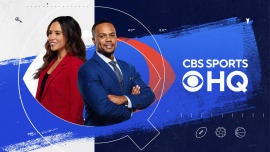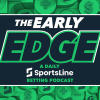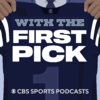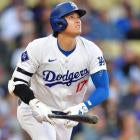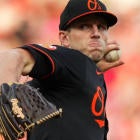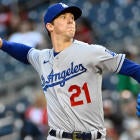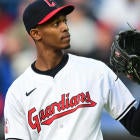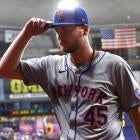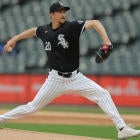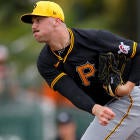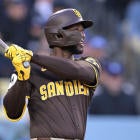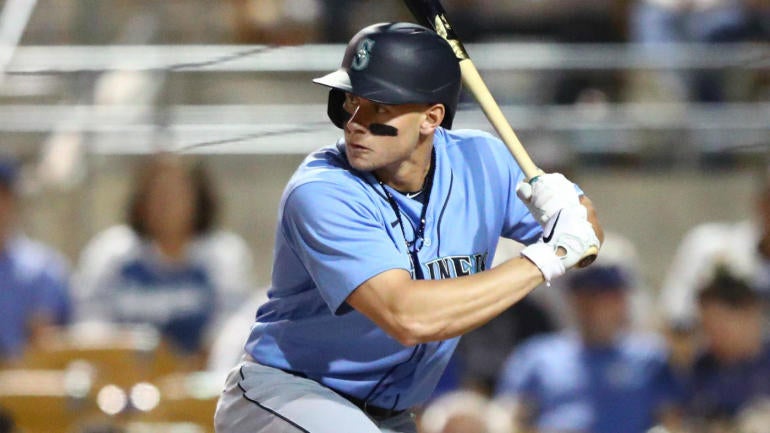
The outfield is never lacking in impact prospects.
It's three times as big as any one infield position, after all, and because chasing down fly balls requires a certain level of athleticism, it tends to house some of the highest-ceiling prospects overall, including many with a chance of contributing a usable number of stolen bases.
So I won't just give you 10 names here, but 20, including several who were only drafted this year. Some are so far down the pipeline that I won't feel completely confident in how I rank them until I have more data, but we work with what we have. Suffice it to say, though, likely 2021 contributors Leody Taveras and Brent Rooker never had a real chance to crack this list given the caliber of prospect they were going up against.
Oh, and for what it's worth, Jo Adell no longer qualifies for this list because of some adjustments MLB made to its rookie eligibility rules in light of the shortened 2021 season. He would rank No. 2 if he did.
Note: This list is intended for a variety of Fantasy formats and thus weighs short-term role against long-term value. Not all of these players will contribute in 2021 — most, in fact, will not — but among prospects, they're the names Fantasy Baseballers most need to know.
1. Jarred Kelenic, Mariners
Age (on opening day): 21
Where he played in 2019: low Class A, high Class A, Double-A
2019 minors: .291 BA (443 AB), 23 HR, 20 SB, .904 OPS, 50 BB, 111 K
The Mets' decision to acquire Edwin Diaz and Robinson Cano from the Mariners is shaping up to be an all-time dunderhead move with the way Kelenic has progressed in the two years since. The 21-year-old excels in all facets of the game, ranking him behind only Wander Franco among all prospects, and if he played for a more competitive team, he surely would have debuted in 2020.
2. Julio Rodriguez, Mariners
Age (on opening day): 20
Where he played in 2019: low Class A, high Class A
2019 minors: .326 BA (328 AB), 12 HR, 26 2B, .929 OPS, 25 BB, 76 K
If you're willing to wait a little longer for the payoff, you could make the case for Kelenic to go behind Rodriguez, who's giving off some strong Juan Soto vibes in the lower minors. He won't run like Kelenic does, but the bat could play louder and the polish is off the charts, as evidenced by him going 30 for 65 with 11 extra-base hits in his first 17 games at high Class A last year.
3. Randy Arozarena, Rays
Age (on opening day): 26
Where he played in 2019: Double-A, Triple-A, majors
2019 minors: .344 BA (343 AB), 15 HR, 17 SB, 1.003 OPS, 37 BB, 71 K
2020 majors: .281 BA (64 AB), 7 HR, 4 SB, 1.022 OPS, 6 BB, 22 K
Arozarena's late-season tear and postseason explosion (he ended up hitting a combined .333 with 17 homers in just 141 at-bats) makes for a fine disruption to these otherwise orderly rankings, and even though he profiled as more like a fourth outfielder once upon a time, his contributions were simply too loud for too long to ignore. Prospecting is largely wish casting anyway, so why not opt for the bird in the hand?
4. Dylan Carlson, Cardinals
Age (on opening day): 22
Where he played in 2019: Double-A, Triple-A
2019 minors: .292 BA (489 AB), 26 HR, 20 SB, .914 OPS, 58 BB, 116 K
2020 majors: .200 BA (110 AB), 3 HR, 1 SB, .616 OPS, 8 BB, 35 K
Carlson was the prospect with all the momentum heading into the 2020 season and mostly failed to live up to it, even getting sent back to the alternate training site for a couple weeks. But he looked more comfortable in a late-season return and made an impact in the playoffs, starting all three of the Cardinals' games to position himself for a possible Kyle Tucker-level breakthrough in 2021.
5. Alex Kirilloff, Twins
Age (on opening day): 23
Where he played in 2019: Double-A
2019 minors: .283 BA (375 AB), 9 HR, 18 2B, .756 OPS, 29 BB, 76 K
We still don't know how much a wrist injury impeded Kirilloff's production in 2019 after he hit .348 with 20 homers, 44 doubles and a .970 OPS the year before, but we can deduce from the rave reviews at the alternate training site. He was entrusted to make his debut during the playoffs, going 1 for 4, and is in line to start in left field with Eddie Rosario gone. There may be Corey Seager potential in his bat.
6. Jasson Dominguez, Yankees
Age (on opening day): 18
Where he played in 2019: did not play
The cancellation of the 2020 minor-league season means we still haven't seen Dominguez as a pro, but the hype is unparalleled, with no shortage of anecdotes supporting the idea he's a legitimate baseball prodigy. Among them: He was wowing scouts from the time he was 13, has registered 108 mph exit velocity from both sides of the plate and could play a capable shortstop if he wasn't so good in center.
7. Ryan Mountcastle, Orioles
Age (on opening day): 24
Where he played in 2019: Triple-A
2019 minors: .312 BA (520 AB), 25 HR, 35 2B, .871 OPS, 24 BB, 130 K
2020 majors: .333 BA (126 AB), 5 HR, 5 2B, .878 OPS, 11 BB, 30 K
Mountcastle's defensive shortcomings (his one true position is "hitter") push him down traditional prospect lists, but after this year's call-up, it's no longer just theoretical how his bat will play. His all-fields approach predisposes him to a high BABIP, and he has learned to elevate enough to meet the power demands of the present era, giving him the look of another Nick Castellanos.
8. Cristian Pache, Braves
Age (on opening day): 22
Where he played in 2019: Double-A, Triple-A
2019 minors: .277 BA (487 AB), 12 HR, 9 3B, 36 2B, .802 OPS, 43 BB, 122 K
2020 majors: 1 for 4, 2 K
An Adam Duvall injury made Pache a fill-in for the Braves during the NLCS, and though he went just 4 for 22, he demonstrated the sort of bat-on-ball skills that keep scouts hopeful his uber-athleticism will take care of the rest. He'll play just for his defense, which rates as plus-plus in center, but there's a real chance he hasn't yet peaked offensively.
9. Kristian Robinson, Diamondbacks
Age (on opening day): 20
Where he played in 2019: short-season Class A, low Class A
2019 minors: .282 BA (255 AB), 14 HR, 17 SB, .881 OPS, 31 BB, 77 K
With the Bahamas being so newly developed as a prospect pipeline, Robinson was expected to be more of a project for the Diamondacks than he's turning out to be, already exhibiting a simple stride, compact swing and disciplined approach. And when he connects, it's the sort of outlier hard-hit rate would neutralize any strikeout issues he might have, generating massive power to go along with some speed.
10. J.J. Bleday, Marlins
Age (on opening day): 23
Where he played in 2019: high Class A
2019 minors: .257 (140 AB), 3 HR, 8 2B, .690 OPS, 11 BB, 29 K
Bleday's assignment to high Class A after the Marlins picked him fourth overall in 2019 was unusually aggressive, which means you shouldn't read too much into the numbers, but you should read into the Marlins' confidence level and how regularly Vanderbilt draftees are fast-tracked to the majors. He won't run at all, but the hope is he hits for average and power with good on-base skills.
11. Riley Greene, Tigers
Age (on opening day): 20
Where he played in 2019: Rookie, short-season Class A, low Class A
2019 minors: .271 (221 AB), 5 HR, 5 SB, .749 OPS, 22 BB, 63 K
The fifth overall pick in 2019 is hit-over-power right now, but that part of his game is so developed for a player his age that adding power is expected to be a light lift as he moves up the ladder. Climbing all the way to full-season ball in his first professional season is especially impressive for a prep pick, so while you're mostly trusting in his pedigree at this point, it's for good reason.
12. Zac Veen, Rockies
Age (on opening day): 19
Where he played in 2019: not under contract
Whatever deficiencies might have held Veen back in the prospect rankings went out the window when the Rockies drafted him ninth overall, positioning him to break into the big leagues in the BABIP-boosting paradise that is Coors Field. That's at least a couple years away, of course, but in that time, Veen's 6-foot-5 frame and natural leverage could help him develop elite power, like on the level of a Cody Bellinger.
13. Corbin Carroll, Diamondbacks
Age (on opening day): 20
Where he played in 2019: Rookie ball, short-season Class A
2019 minors: .299 BA (154 AB), 2 HR, 7 3B, 9 2B, 18 SB, .896 OPS, 29 BB, 41 K
Power isn't a big part of Carroll's game, which could make him a tough sell in today's power-laden environment, but the hit tool and especially the speed are so superlative that he's an unusually safe bet to wind up as a full-time big-leaguer. He sprays line drives all over the field and is smart about implementing his speed, which gives him a better chance of maximizing his steals output in the majors.
14. Trevor Larnach, Twins
Age (on opening day): 24
Where he played in 2019: high Class A, Double-A
2019 minors: .309 (476 AB), 13 HR, 30 2B, .842 OPS, 57 BB, 124 K
Larnach is a disciplined hitter with a plus hit tool whose power has yet to fully manifest because he's so opposite field-minded. The Twins remain confident he'll adjust his approach to make the most of his gifts, but he's getting to an age where he needs to start making hay, particularly with Alex Kirilloff having beaten him to the big leagues.
15. Drew Waters, Braves
Age (on opening day): 22
Where he played in 2019: Double-A, Triple-A
2019 minors: .309 BA (527 AB), 7 HR, 9 3B, 40 2B, .819 OPS, 39 BB, 164 K
Waters is kind of like fellow Braves farmhand Cristian Pache. Yes, defense will be his carrying tool, but while the production is mostly theoretical right now, the evaluations remain bullish because of his steady progression and premier athleticism. He has a swing geared for line drives and a knack for going the opposite way, but unlike Pache, strikeouts are an issue.
16. Brennen Davis, Cubs
Age (on opening day): 21
Where he played in 2019: low Class A
2019 minors: .305 (177 AB), 8 HR, 4 SB, .907 OPS, 18 BB, 38 K
Though basketball divided his attention in high school, Davis has looked polished to begin his professional career, reaching base at a high clip while just scratching the surface of his power potential, which should only increase as he grows into his 6-foot-4 frame. He profiles as a base-stealer, too, giving him an enticing tools package that could launch him up the rankings as he moves up the ladder.
17. Garrett Mitchell, Brewers
Age (on opening day): 22
Where he played in 2019: not under contract
Mitchell's slide to the Brewers at 20th overall on draft day has adversely affected his placement in prospect rank lists, but he was the toolsiest player in the entire draft class, offering the sort of game-changing speed that every Roto player covets. He may lean on it too much as a hitter, swinging for grounders, but there's enough raw power for him to break out big with adjustments.
18. Heston Kjerstad, Orioles
Age (on opening day): 22
Where he played in 2019: not under contract
Kjerstad was a surprising choice at No. 2 overall this year and is polarizing for reasons beyond that, demonstrating massive power potential but with some mechanical issues that leave him vulnerable to strikeouts. Evaluators, thus, are divided over whether he'll develop into a well-rounded hitter or more of an all-or-nothing type. Given his age, we should know sooner than later.
19. Brandon Marsh, Angels
Age (on opening day): 23
Where he played in 2019: Rookie ball, Double-A
2019 minors: .287 BA (380 AB), 7 HR, 19 SB, .776 OPS, 47 BB, 99 K
Marsh's underwhelming power output might have you steering clear, but his switch to a more upright stance midway through 2019 led to him hitting .339 with 7 home runs and a .924 OPS in his final 51 games between Double-A and the Arizona Fall League. He's sort of Jesse Winker-like in that you're just begging for the power to come through because his offensive profile otherwise is strong.
20. Heliot Ramos, Giants
Age (on opening day): 21
Where he played in 2019: high Class A, Double-A
2019 minors: .290 BA (389 AB), 16 HR, 24 2B, .850 OPS, 42 BB, 118 K
Ramos has had an up-and-down minor-league career, but our last glimpse of him in 2019 showed him trending the right direction, with his power beginning to play up as he crossed into the upper minors. He was still just a teenager when he first moved up to Double-A, too, which means he's still playing with house money developmentally and deserves more benefit of the doubt considering.


